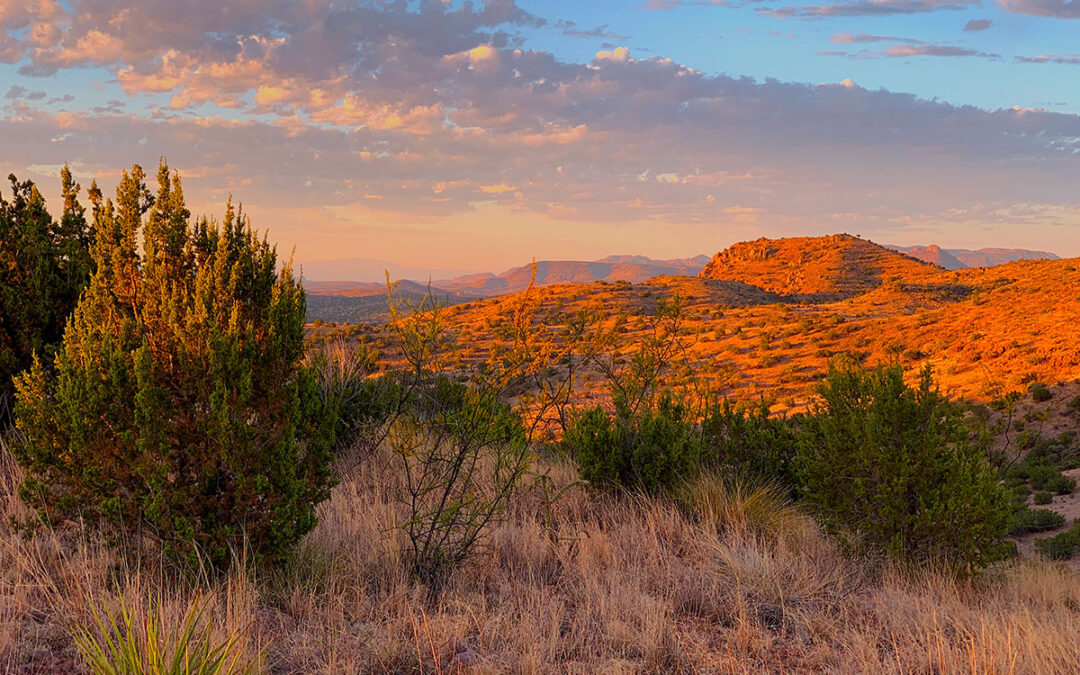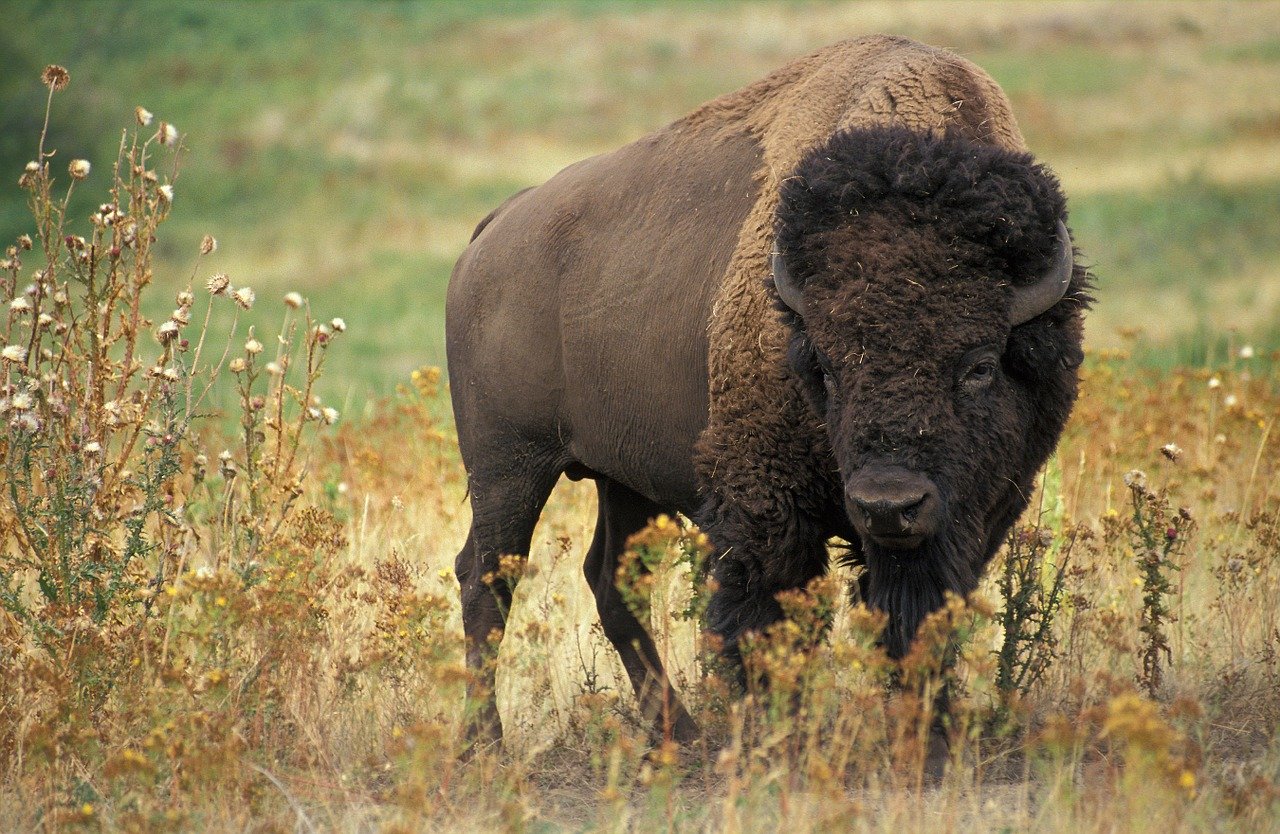Wild sheep and sheep country have inspired a rich tradition of longing, struggle and adventure, perhaps a richer tapestry of hunting lore and literature. Some of it even true. Bighorns. Dall’s. Stone’s. Desert. Argalis. Snow sheep. These are the regal rams of fevered dreams.
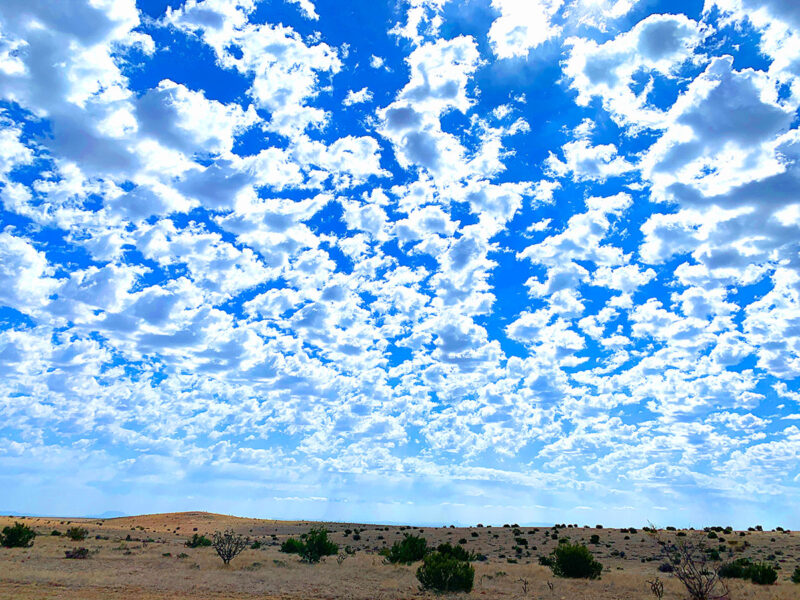
Fortunately, there’s Texas. Dry, sandy, rocky and so similar to the harsher mountains of North Africa that aoudad didn’t notice the difference.
Aoudad? Not so much. Maybe that’s because the aoudad isn’t really a sheep, but more of an ancient sheep/goat oddity, the only member of its own genus, Ammotragus (Greek for sand goat). More likely the paucity of aoudad hunting stories reflects its native range in North Africa’s desert mountains behind the imposing wall of the Barbary Coast, an uninviting land infamous for sand, piracy, slavery, murder and associated violence for centuries. Thomas Jefferson and his nascent U.S. Navy interrupted this insanity briefly in the early 19th century with sufficient success to give rise to the Marine’s Hymn on the shores of Tripoli. Alas, on those same shores just a few years ago, Isis thugs were again beheading Christians. What goes around comes around. And it’s not good optics for Libyan tourism.
Fortunately, there’s Texas. Dry, sandy, rocky and so similar to the harsher mountains of North Africa that aoudad didn’t notice the difference when they were liberated into wild West Texas in the late 1950s.
“We’ve been hunting here for about 27 years now,” Backcountry Hunts owner Steve Jones told me. “Mule deer, Carmen deer, aoudad. And now elk. But the aoudad do the best. They’re just cut out for this steep, rocky, dry cactus country. We’ve got lots of them.” Makes for the best little aoudad hunt.
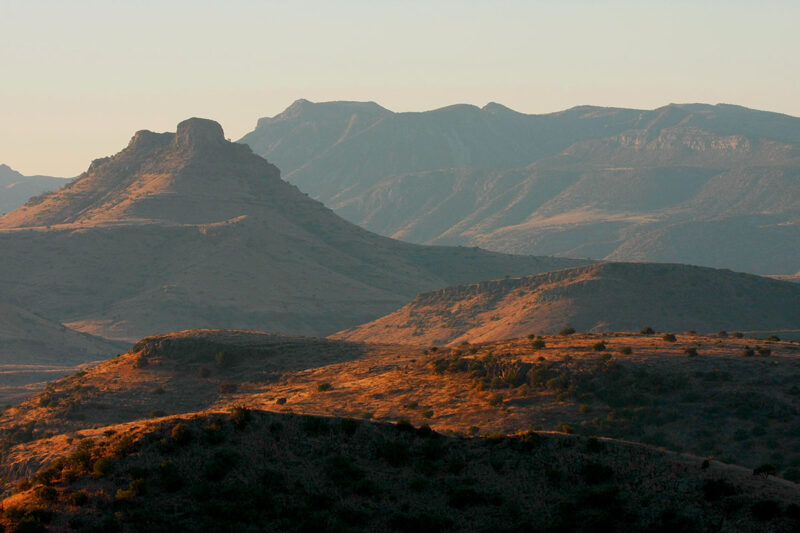
“Aoudad are just cut out for this steep, rocky, dry cactus country.”
That’s good, because Africa no longer does. Five thousand, at best 10,000 still cling to a precarious existence in pockets of extremely harsh, isolated country from northwest Somalia west to Morocco. Overgrazing by domestic livestock over centuries has degraded habitats to the point of desertification. Poaching has done the rest. It’s the same story for wildlife across North Africa and the Middle East. Scimitar horned oryx. Arabian oryx. Addax. Lion. Cheetah. All gone or nearly so.
Texas to the rescue. Texas game ranchers have sent breeding stock of oryx and addax back to their native lands. Perhaps someday they’ll have to do the same with aoudad. In the meantime, they have their hands full preventing overpopulation in the Lone Star State. Herds of hundreds of aoudad swarm across many parts of rugged southwest Texas, especially the Big Bend country south of Marfa.
“This place is nasty,” I pronounced after concluding a hot, steep, four-mile walk-about that some might have described as a center-ring balancing act atop an incline of broken stones interspersed with marbles on slopes littered with jagged boulders. But there was a safety net, a sparse blanket of prickly pear pads, catclaw vines and hook-branched brush too unapproachable to even have a name.
“Keeps out the riff-raff,” replied guide, mechanic, and all-round “Mr. Fix-It” genius Dave Callaway, the MVP with Backcountry Hunts for 10 years running.
“But not Pancho Villa, I’ve heard.”
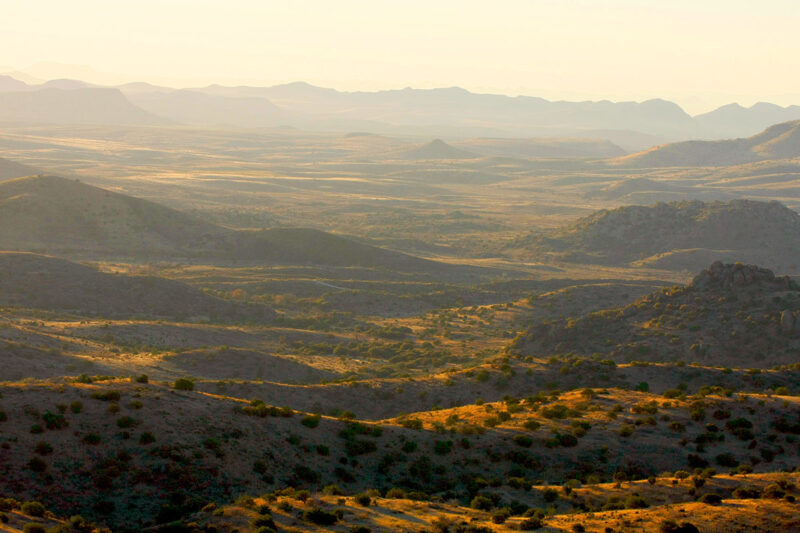
“This place is nasty.”
“No. No. Not him. And plenty more like him. This was outlaw heaven.”
“Still is,” chimed in Shane Zimmerman, the youngest guide in the Backcountry Hunt stables. Shane gave a head nod toward the Border Patrol’s infrared surveillance balloons hovering in the far distance. Drug smuggling, human trafficking. Rough country is the last refuge for scoundrels and criminals. Present company excluded.
“There’s some. Rams.” Dave nodded west as he reached for the spotting scope. “That far ridge, just below the skyline. Left of that lone juniper.” His directions were good. My eyesight was not. But, through the magic of magnification, I eventually determined the cluster of tawny boulders I was perusing was moving. “Grazing down toward the bottom. There’s water down there. Bet that’s where they’re headed. Let’s mosey on over there.”
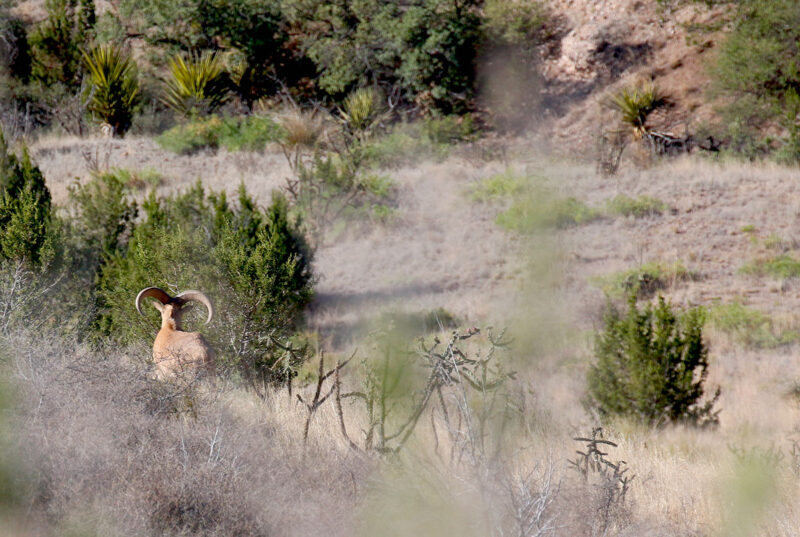
“There’s some. Rams.”
The moseying was easier than it might have been thanks to Dave’s Polaris Ranger, the most sure-footed conveyance in wicked West Texas after a mule. And a more comfortable ride, especially if you’re packing tripod, scope, cooler, drinks, lunch, binoculars, cameras and the rest of a modern hunter’s “essentials.” The vast ranch we were hunting has been cut and beaten—mostly beaten—into approximations of two-tracked trails since WWII when Jeeps first began venturing onto it. Dusty, rocky, tilted. The tortured pathways follow the lines of least resistance, crossing dry washes and climbing ridges to waterholes and windmills that hydrate local wildlife as well as scattered cattle. The trails are bordered by acacia, yucca and mimosa brush that whips, scrapes and bleeds passing vehicles, arms and faces. Mockingbirds, blue grosbeaks and Montezuma quail love it.
“There they are!” Dave stopped the Ranger with a jolt and grabbed his binocular. “Just on the lip of the canyon.”
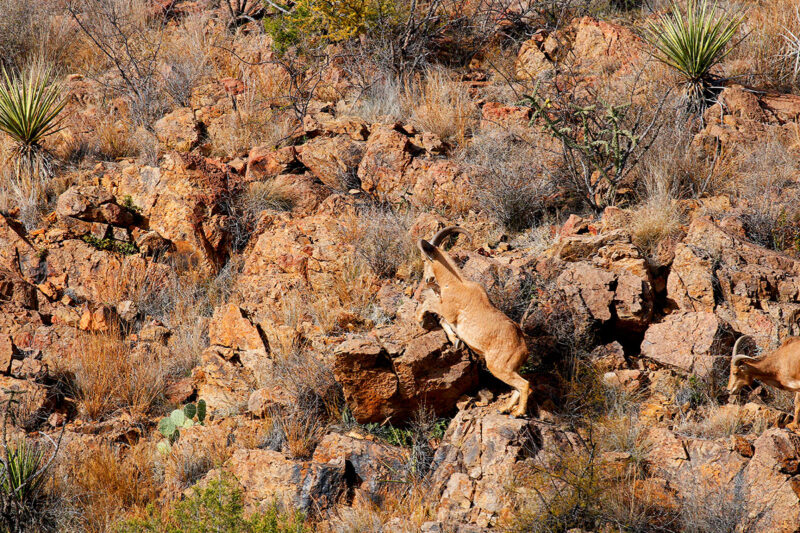
We were about to turn around in defeat. I was pontificating for the cameras. Shane was giving it one last scan.
“Coming right at us,” Shane noted. Indeed they were. Seven rams, the first six peas in a pod, the seventh slightly bigger. Above and beyond them, a half dozen more. But not the 30-inch specimen I’d set as my goal. “A 30-inch ram is like a 350 elk or 170 whitetail,” Dave once told me. “Old. A good benchmark to shoot for. But not noticeably more dramatic than a 28. Mostly our hunters take 26- to 29-inch rams. Lions get a lot more.”
I’d taken two or three representative aoudad over the years. On this hunt, being filmed for an Amazon Prime series called “Wildcraft: West of Somewhere,” I wanted to hold out for that rarer, older ram sporting a horn measuring 30 inches base to tip. “They’re out here,” Shane insisted. “I saw one just last week. If you want to hike, I think we can find one.”
I wanted to hike. Maybe not as far or high or dry as we did. Here’s what happened:
It was our fourth morning. Dave was driving. We’d seen hundreds of aoudad, more than a dozen “good enough” rams, none with 30-inch horns – best little aoudad hunt, indeed.
Last day, so I was ready to compromise an inch. Maybe two. “There he is!” Dave stopped, pointed. Two rams weaving through the brush. Shane and I dismounted. A fleeting shooting lane opened, closed. Dark horns flashed, disappeared, bobbed up again, dropped over the ridge. We gave chase. “Just over this hump,” Shane coaxed. “Get ready.”
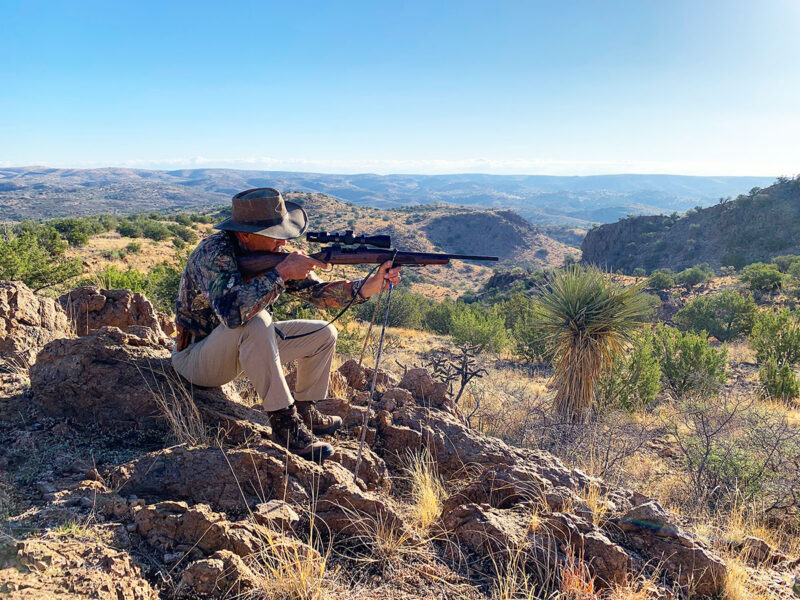
Contemplating a shot: shooting sticks help Spomer steady his rifle for the shot.
Nothing. False summit. We climbed higher. And higher. The rams had to be just ahead, standing on the backside of that hill. Maybe in the next draw. Perhaps walking up the far side. Just 326 yards. Easy range for the 260 Remington. If they’d been there. What about farther down the south side?
We were about to turn around in defeat. I was pontificating for the cameras. Shane was giving it one last scan.
“There they are. Maybe not the same two, but a bunch of rams. Could be our two joined those.” We counted 10, a dozen in a shadowed canyon nearly a mile away. “Probably more in all those rocks.”
“Lots of eyeballs.”
“Yea, but if we drop into this ravine it’ll lead us into the bottom. We keep under that lip, go along the wash to that side ridge, pop over. Should be inside 300 yards.” Solar winds were kicking up with the heat. The morning was almost over. In our haste we’d left our packs. No water.
“Let’s go for it.”
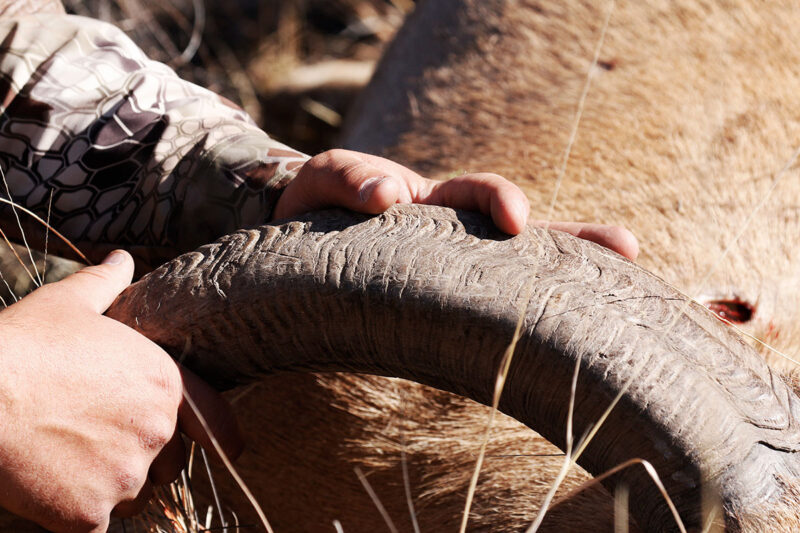
A 30-inch ram is like a 350 elk or 170 whitetail.
By the time we reached that side ridge, half the rams had bedded. We counted 13. “Look way to the right. Lower. Two more there. No, four.”
“Any big ones?” We watched, glassed, assessed, shifted right and left, crawled under and around brush slow as sloths. Crept closer, cut the range from 400 yards to 360, 300, 225. Glassed and studied. “What about that one under the three small rams lying on those rocks? Way left. Down in the shadows.”
“Maybe. But one of those on the far right looks pretty good.” The wind was south. In our faces. The rams were lethargic, standing, bedding. But our clock was ticking. Almost noon.
“That one! Coming out of the draw. By that yucca. See it? That’s the biggest.”
I scraped the ground free of cactus spines and sat, back against a thorny shrub. Spread the shooting sticks, settled the rifle in the crotch, chambered a round. Shawn hit the rangefinder and it sent a signal to my scope, illuminating the aiming point. The amber dot glowed on the ram’s right side. “Wait’ll he turns.” But he wasn’t turning. He was walking almost straight away, climbing out of the draw, sidling around a wall of rock. “If he gets on the backside of that he might be gone.”
And then the tawny goat stopped, his goatee and chaps fluttering in the wind. He turned slightly and looked across at another ram. Enough room to target the ribs, the offside shoulder in line with the bullet’s trajectory.
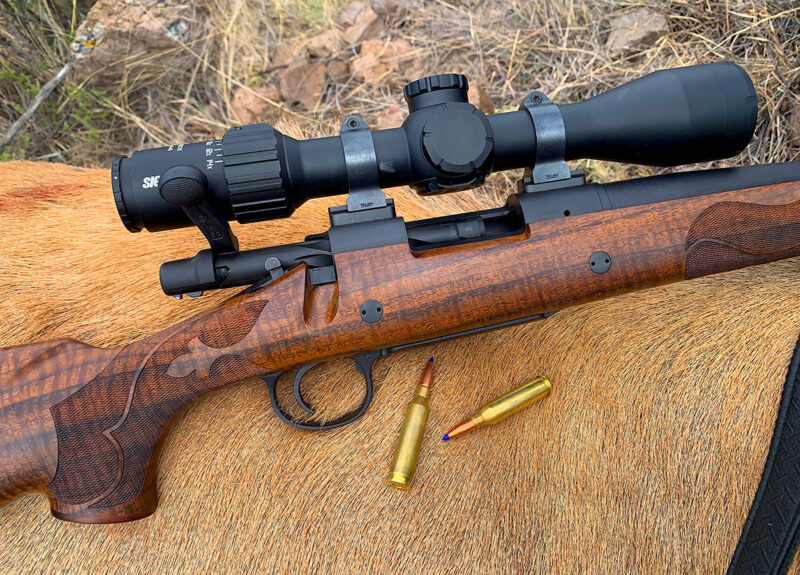
The 120-grain TTSX punched thorugh the paunch, laced the lungs, broke the off shoulder and exited the ram.
“You missed!”
“No.”
“I saw dust fly from the rock above him.”
“Shot felt good. He was humped up going over the top.”
“Why didn’t you shoot again?”
“Didn’t want to shoot the wrong one.” A second ram had erupted from behind the rock, running neck and neck with mine. What we hoped was mine.
“But I saw the hit on the rock.”
“Barnes bullet. They often shoot through. He’s gotta be piled up just over the top.” I was trying to convince myself as much as Shane.
Ours was a long, slow, hot climb down, across and over. “Steeper than it looked,” I said, wiping sweat. “Here’s that rock face. I’ll check for blood, hair, maybe a bullet splatter on the rock. Why don’t you look for a blood trail above.”
There was no blood. No hair. Just tracks upon tracks and dry droppings and the sun beating down hope. And then Shane shouting. I scrambled up. “Yo!” Shane smiling.
“Find him?”
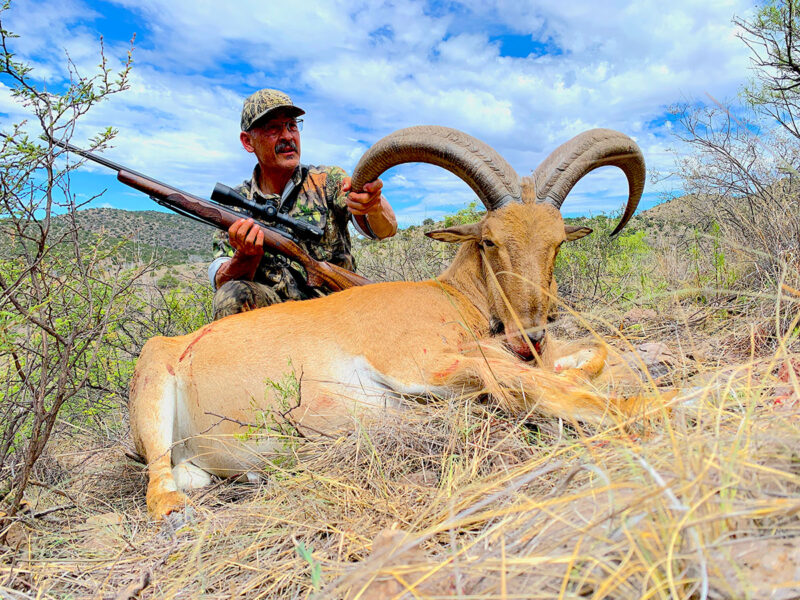
The horns on Spomer’s ram stretched just beyond 30 inches.
“Saw this bright yellow spot.” My young guide pointed. The ram’s pale belly. He’d fallen in a thicket of mimosa brush, multiple thorny branches arresting his roll, nearly covering him. The 120-grain TTSX, launched at 2,870 fps, had punched through the paunch, laced the lungs, broke the off shoulder and punched out to powder the rock while the ram launched its final 50-yard dash. Shane’s careful searching had worked. The horns stretched just beyond 30 inches.
Epilogue:
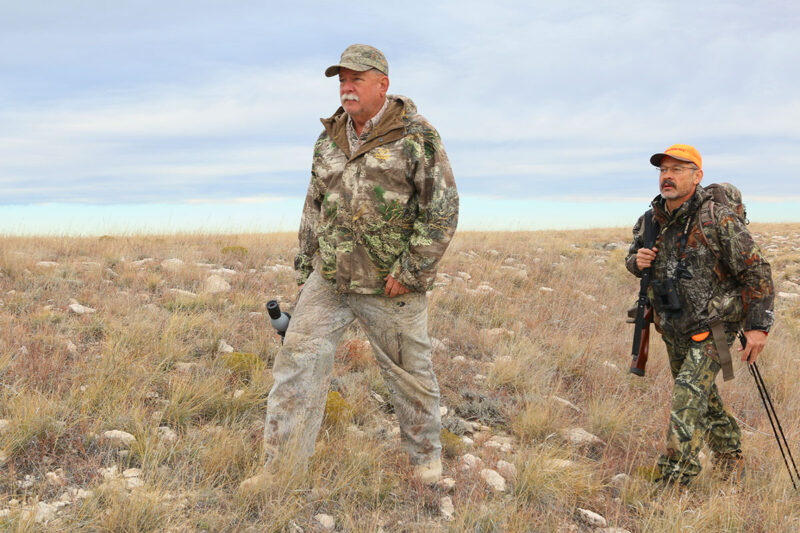
Steve Jones leads Spomer across terrain he describes as “broken stones interspersed with marbles on slopes littered with jagged boulders.”
Contrary to conventional wisdom, aoudad flesh is not inedible. Or even “funny tasting.” A bit tough, given just 36 hours of aging, but tasty enough after the culinary care of campmates Luke Hartle and Len Waldron. We all went for seconds. Even more delectable was the equally reviled javelina I’d shot. This was my second collared peccary cuisine, reinforcing my first impression. Handled properly, it’s every bit as delectable as a half dozen other top game meats.
Our camp was a combination of overland trailers with pop up tents on the roof and expansive nylon Guide Gear teepees with floors to keep out snakes and scorpions, screened windows to admit night breezes, no small matter in late May southeast of El Paso. Backcountry Hunts provides rough, bunkhouse-style room and board with running water, but we were testing a variety of hunting, camping and traveling tools, all highlighted on the “Wildcraft” series now airing on Amazon Prime.
There were four of us hunting followed by a professional crew of Hollywood sound engineers (I kid you not) and videographers, all of whom suffered the heat, dust, rocks, thorns and gravity of the situation more than did we hunters. All were cooperative and enthusiastic. If you ever have an opportunity to hunt with a three- or four-member crew following you around, pass it up.
While all hunters and videographers “got their game,” Texas extracted its pound of flesh, too. A rocky slope flipped a historically stable, reliable four-wheel drive truck two-and-a-half times, breaking legs and ribs. A helicopter rescue by the Border Patrol saved the day. It’s all documented on the series, if you care to watch. I will.
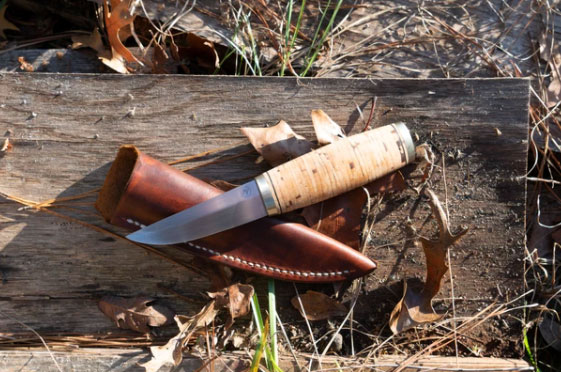 In Nordic countries, the Puukko is a small, traditional, general purpose carry knife. The 3½-inch blade of 52100 steel features a complex “Rhombic” grind designed to lighten and stiffen the blade. The stacked Birchbark handle is warm and comfortable and features nickle-silver fittings. A handmade leather sheath comes with each knife. Buy Now
In Nordic countries, the Puukko is a small, traditional, general purpose carry knife. The 3½-inch blade of 52100 steel features a complex “Rhombic” grind designed to lighten and stiffen the blade. The stacked Birchbark handle is warm and comfortable and features nickle-silver fittings. A handmade leather sheath comes with each knife. Buy Now
